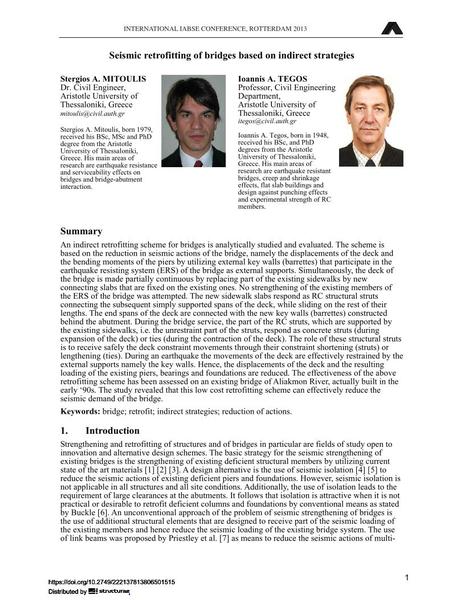Seismic retrofitting of bridges based on indirect strategies

|
|
|||||||||||
Bibliografische Angaben
| Autor(en): |
Stergios A. Mitoulis
Ioannis A. Tegos |
||||
|---|---|---|---|---|---|
| Medium: | Tagungsbeitrag | ||||
| Sprache(n): | Englisch | ||||
| Tagung: | IABSE Conference: Assessment, Upgrading and Refurbishment of Infrastructures, Rotterdam, The Netherlands, 6-8 May 2013 | ||||
| Veröffentlicht in: | IABSE Conference, Rotterdam, May 2013 | ||||
|
|||||
| Seite(n): | 334-335 | ||||
| Anzahl der Seiten (im PDF): | 8 | ||||
| Jahr: | 2013 | ||||
| DOI: | 10.2749/222137813806501515 | ||||
| Abstrakt: |
An indirect retrofitting scheme for bridges is analytically studied and evaluated. The scheme is based on the reduction in seismic actions of the bridge, namely the displacements of the deck and the bending moments of the piers by utilizing external key walls (barrettes) that participate in the earthquake resisting system (ERS) of the bridge as external supports. Simultaneously, the deck of the bridge is made partially continuous by replacing part of the existing sidewalks by new connecting slabs that are fixed on the existing ones. No strengthening of the existing members of the ERS of the bridge was attempted. The new sidewalk slabs respond as RC structural struts connecting the subsequent simply supported spans of the deck, while sliding on the rest of their lengths. The end spans of the deck are connected with the new key walls (barrettes) constructed behind the abutment. During the bridge service, the part of the RC struts, which are supported by the existing sidewalks, i.e. the unrestraint part of the struts, respond as concrete struts (during expansion of the deck) or ties (during the contraction of the deck). The role of these structural struts is to receive safely the deck constraint movements through their constraint shortening (struts) or lengthening (ties). During an earthquake the movements of the deck are effectively restrained by the external supports namely the key walls. Hence, the displacements of the deck and the resulting loading of the existing piers, bearings and foundations are reduced. The effectiveness of the above retrofitting scheme has been assessed on an existing bridge of Aliakmon River, actually built in the early ‘90s. The study revealed that this low cost retrofitting scheme can effectively reduce the seismic demand of the bridge. |
||||
| Stichwörter: |
Brücke Retrofit
|
||||
